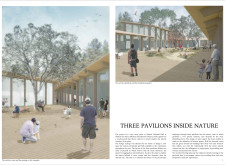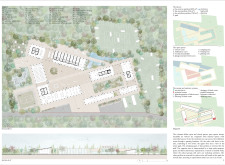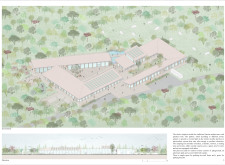5 key facts about this project
The design for the new entry point to Kemeri National Park features a thoughtful arrangement of three pavilions connected by a wooden pathway. Located in a landscape known for its rich ecosystem, the project aims to enhance accessibility and community involvement. The design encourages visitors to engage with both the built structures and the surrounding nature. Two inner courtyards serve as focal points for social interaction and quiet reflection, inviting a sense of connection to the park.
Design Concept
The concept centers on blending indoor and outdoor spaces. This approach fosters a relationship between the architecture and the natural surroundings. The layout is organized to promote exploration, allowing visitors to navigate freely between the pavilions and experience the landscapes. By creating open areas that facilitate movement, the design helps visitors feel connected to the environment.
Spatial Organization
Each pavilion serves a specific purpose, such as offering visitor services or hosting recreational activities. This clear separation of functions allows for efficient use of space and aids in visitor flow. The inner courtyards act as gathering spots, where groups can meet or find quiet areas for contemplation. This organization supports both social engagement and individual experiences within the park.
Material Use
Wood is the main material used in the design, particularly for the flooring and pathways. This choice aligns with a commitment to sustainability while also enhancing the aesthetic quality of the site. Wooden pathways guide visitors through the project, encouraging them to take in various views and experiences. The materials selected contribute to a sense of openness and warmth in the overall environment.
Design Detail
The wooden pathways are carefully aligned with existing trails in the park. This thoughtful design creates continuity between the new structures and the natural terrain. As visitors walk along the paths, they encounter different perspectives of the landscape, inviting moments of reflection. The layout enhances accessibility, making it easier for everyone to explore the beauty of Kemeri National Park.






















































